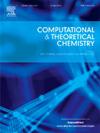Hydrogen storage on a star-like CBe₅Li₅+ superalkali cluster featuring planar pentacoordinate carbon
IF 3
3区 化学
Q3 CHEMISTRY, PHYSICAL
引用次数: 0
Abstract
The hydrogen storage capacity of the star-like planar pentacoordinate carbon (ppC) superalkali cluster CBe₅Li₅+, whose high stability can be understood through the 18-electron rule, was studied using density functional theory (DFT). The obtained results showed that H₂ adsorbs on the CBe₅Li₅+ cluster in molecular form, and the cluster remains planar and stable even after adsorption. Importantly, the CBe₅Li₅+ cluster is predicted to be a promising candidate for hydrogen storage material, achieving a gravimetric density of up to a theoretical limit of 25.8 %. Additionally, molecular dynamics (MD) simulations were performed on CBe₅Li₅+, 5H₂@CBe₅Li₅+, 10H₂@CBe₅Li₅+, 15H₂@CBe₅Li₅+, and 16H₂@CBe₅Li₅+ clusters at room temperature to study the adsorption and desorption of H₂ molecules over time. The MD simulations revealed that the majority of adsorbed hydrogen molecules shifted out of the cluster within 300 fs; however, some H₂ molecules remained bound to the cluster. In ADMP molecular dynamics simulations, H₂ was considered bound to the CBe₅Li₅+ cluster when the minimum H–cluster atom distance stayed under 2.5 Å. A distance exceeding 3.0 Å with continuous separation, lacking oscillations, signified desorption from the cluster surface. The energy analysis from MD simulations indicated that the structures are dynamically stable. Even after H₂ adsorption, the planarity of the CBe₅Li₅+ cluster is retained, confirming its stability. These findings suggest that CBe₅Li₅+ is a structurally strong and efficient candidate for next-generation hydrogen storage applications.

在具有平面五坐标碳的星形CBe₅Li₅+超碱簇上储氢
使用密度泛函理论(DFT)研究了星形平面五坐标碳(ppC)超碱簇CBe₅Li₅+的储氢能力,其高稳定性可以通过18电子规则来理解。所得结果表明,H₂以分子形式吸附在CBe₅Li₅+簇上,即使吸附后簇仍保持平面和稳定。重要的是,CBe₅Li₅+团簇预计将成为储氢材料的有希望的候选者,其重力密度可达到25.8%的理论极限。此外,在室温下对CBe₅Li₅+,5H₂@CBe₅Li₅+,10H₂@CBe₅Li₅+,15H₂@CBe₅Li₅+和16H₂@CBe₅Li₅+簇进行了分子动力学(MD)模拟,以研究H₂分子随时间的吸附和脱附。MD模拟表明,大部分吸附的氢分子在300 fs内移出团簇;然而,一些H₂分子仍然束缚在团簇上。在ADMP分子动力学模拟中,当最小H -簇原子距离保持在2.5 Å以下时,H₂被认为与CBe₅Li₅+簇结合。距离超过3.0 Å且连续分离,缺乏振荡,表示从团簇表面脱附。MD模拟的能量分析表明,结构是动态稳定的。即使在H₂吸附后,CBe₅Li₅+团簇的平面度也被保留,从而证实了其稳定性。这些发现表明,CBe₅Li₅+是下一代储氢应用的结构强大且高效的候选者。
本文章由计算机程序翻译,如有差异,请以英文原文为准。
求助全文
约1分钟内获得全文
求助全文
来源期刊

Computational and Theoretical Chemistry
CHEMISTRY, PHYSICAL-
CiteScore
4.20
自引率
10.70%
发文量
331
审稿时长
31 days
期刊介绍:
Computational and Theoretical Chemistry publishes high quality, original reports of significance in computational and theoretical chemistry including those that deal with problems of structure, properties, energetics, weak interactions, reaction mechanisms, catalysis, and reaction rates involving atoms, molecules, clusters, surfaces, and bulk matter.
 求助内容:
求助内容: 应助结果提醒方式:
应助结果提醒方式:


